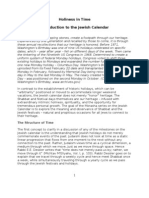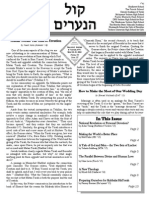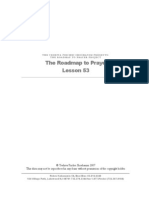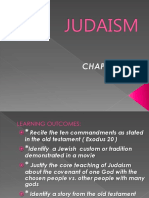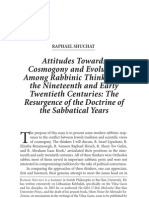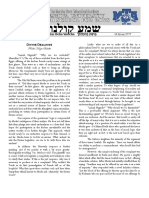From Too Particular To Too Universal and Back Again: Rabbi Kenny Schiowitz
Uploaded by
outdash2From Too Particular To Too Universal and Back Again: Rabbi Kenny Schiowitz
Uploaded by
outdash2From Too Particular to Too Universal and Back Again
Rabbi Kenny Schiowitz
Rabbi. Congregation Shaare Tefillah, Teaneck, NJ Faculty, Ramaz Upper School, New York, NY coordinator of www.hschinuch.org, a project of the Yeshiva University Institute for University-School Partnership The two major holidays that bookend the Jewish year are Pesach and Sukot. These weeklong festivals commence exactly half a year apart from one another and are in some ways polar opposites, while at the same time are inextricably linked in law and philosophy. This article will attempt to reflect on the fundamental philosophies that unite and divide these two celebrations. Chazal highlight this connection through the application of the gezeira shava Tu-Tu, the exegetical tool that enables the transposition of the laws of Sukot to Pesach and vice versa. We will see that this legal mechanism is responsible for many of the fundamental laws of the holidays and represents the spiritual and philosophical underpinnings as well. The basic obligation to eat in a suka on the first night of Sukot is based on this connection: R. Yochanan said in the name of R. Shimon b. Yehotzadak, it says here (regarding Sukot) the fifteenth and it says regarding Pesach the fifteenth. Just as there is an obligation to eat matza on the first night of Pesach and the rest of the holiday it is optional, similarly we must eat bread in the suka on the first night of Sukot and the rest of the holiday it is optional. . Sukkah 27a Much halachic literature has been devoted to the exploration of the precise parameters of this connection. Some rishonim insist that the amount of bread necessary to be eaten on the eve of Sukot is an olives volume, mirroring the volume of matza that must be consumed on the first of Pesach, while others require an eggs volume, consistent with the general principles of the laws of suka.27
27
Ran in Brachot folio 12b (of the Rif) d.h. Matnitin. 38
Yeshiva University A To-Go Series Tishrei 5773
Similarly, some say that rain exempts one from eating in the suka like the rest of Sukot,28 while others derive an obligation to eat even in the rain based on the comparison to Pesach.29 The Pri Megadim30 goes so far as to say that one must eat water-challah (bread made of four and water alone) on the first night of Sukot similar to the matza of Pesach (despite the fact that it is chametz!) The debates revolve around the ambiguity of exactly how similar these holidays are supposed to be and to what extent they maintain their unique individual identities. The same can be said of their philosophical identities. I would like to explore that relationship. How are these two holidays indeed polar opposites and what are their similarities and points of integration? The prominence of these two holidays and their respective months is illustrated by this Tanaitic debate: The Beraita states: R. Eliezer said that the world was created in Tishrei, our forefathers were born in Tishrei and died in Tishrei The Jews were redeemed in Nisan and their future redemption will be in Tishrei. R. Yehoshua said that the world was created in Nisan, our forefathers were born in Nisan and died in Nisan The Jews were redeemed in Nisan and their future redemption will be in Nisan. Rosh HaShana 10b-11a ... . ... . :-
R. Eliezer believes that the creation of the world occurred in the month of Tishrei, while R. Yehoshua insists that it occurred in Nisan. It goes without saying that their debate is not rooted in the carbon dating of fossils to the closer half-year. It is also not a coincidence that they each believe that the births and deaths of the forefathers occurred in those same months, as well as the date of the future redemption. Clearly, R. Eliezers view is predicated on the perspective that Tishrei is the focal month of the year and is therefore most likely to be the time of the most historic events of all time, while R. Yehoshua sees Nisan as the month most apropos for these historic events. Their debate is a reflection on their differing perspectives on the relative importance of these months. Nisan marks the birth of the Jewish People. This nation was forged through the shared experience of persecution and slavery and through the historic, miraculous redemption from Egypt. The entire month of Nisan is defined by this holiday at its center. Nisan marks the uniqueness of the Jewish People and the particular destiny that it possesses. In this sense, Nisan is the beginning of everything and is therefore designated as the first of the months, as God commanded in Egypt: This month should be to you the first of all months. It is the first for you for all of the months of the year. Shemot 12:2
28 29
: :
Tosfot in Brachot 49b and Teshuvot HaRashba, quoted by Beit Yosef in O.C. 639. Rosh in Brachot Chapt. 7 siman 23. 30 O.C. 643. See Ran (end of Chapt. 2) of Sukah and Tzlach (Pesachim 108) who dispute this. 39
Yeshiva University A To-Go Series Tishrei 5773
We are to calculate our time through the lunar months, beginning with Nisan. The Midrash, however, limits this designation and focuses on the seemingly superfluous, yet insignificant word lachem: To you the first of all months- To you and not to the nations of the world because the nations of the world count from Tishrei. Pesikta Zutreta, Shemot ch. 12 " " - "" - , ) (
The Midrash insists that even when other nations follow a lunar calendar, they begin their year with Tishrei. The importance of Nisan is limited to the particular interests of the Jews. With respect to the rest of the world, it is Tishrei that is most significant. Thus we can suggest that Rav Eliezer believes that with respect to the creation of the entire world, the event with the most universal significance, it is Tishrei that is most aptly suited to be its date. Rav Yehoshua, however, sees the world from the perspective of the Jewish People, and sees the unique mission of the Jewish People to be the purpose of creation and therefore dates the creation of world at Nisan. In a sense, perhaps Rav Yehoshua reflects the view of the Midrash, quoted by Rashi in the beginning of the Torah: In the beginning, God created- This verse demands interpretation, like the interpretation of our rabbis, [the world was created] for the purpose of the Torah which is called the first path and for the purpose of the Jewish People who are called the first crop. Rashi, Bereishit 1:1 - , " ( ) , .) ( " :
The identity of Tishrei is also manifest in the holidays that populate the month. It begins with Rosh HaShana and is centered around Sukot. Throughout Sukot we bring seventy cows in the musaf services. The korban musaf represents the essence of the kedushat hayom, sanctity of the day. In this case, Chazal say: R. Elazar said: These seventy cows, correspond to whom? They correspond to the seventy nations. Suka 55b )( ][ .? :
The seventy korbanot represent the seventy nations of the world on whose behalf we pray and sacrifice on Sukot. The essence of Sukot is our universal concern for all of the peoples of the world. This theme of Sukot is also represented by the essential symbol of the holiday: the sukah. The Midrash says that this mitzvah will have application to the non-Jewish community as well. The Midrash states that in the end of days God will give rewards to those who kept his Torah and the nations of the world will claim that they were never given the opportunity to keep the Torah. God will then give them one last chance and He will choose the mitzvah of sukah for them to perform and test if they are able to sit in the Suka when it is very hot outside. It is noteworthy that of all of the mitzvot to choose from, it is suka in particular that is chosen for this special test. Why suka? Perhaps this is a reflection of the universal nature of suka, and it is indeed the most relevant one to share with the general population. Additional support for the universal nature of Sukot can be found in the particular laws of the sukah. The halacha is most
40
Yeshiva University A To-Go Series Tishrei 5773
stringent with respect to the materials that are valid for schach (the roof of the suka) in contrast to the walls, that can be made of anything. In addition, some of the walls can be imaginary, as we derive the requisite dimensions from the laws of eruv and construct our sukot from them. This may represent that fact that the suka focuses on that which unites us, that which is Above, and downplays the walls, the representation of that which divides us. The essence of Rosh Hashana is that it is the Day of Judgment. The liturgy expresses this theme but is careful to express the universal nature of this judgment: And so, place you fear, God our Lord on all of Your works and your dread on everything You created. All of the works will fear You and all who were created will bow to you. Everyone will create a single group to fulfill Your will whole heartedly. Our Lord and Lord of our fathers, rule over the entire world with Your honor and be elevated over the whole earth with Your glory. Reveal Yourself with your glorious strength over all inhabitants of the earth and let all that has been made know that You are the Maker and everything that has been fashioned that You were the one Who fashioned Regarding the nations, it is said on this day, which ones will go to war? This is the day of the creation of the world. On this day, all of the creations of the world will stand judgment. ' - , . , ... - - , , , ., , .... ... ..
The belief that the entire world stands in judgment on this birthday of the world is perfectly consistent with the theme of Tishrei. The basics fact that Rosh HaShana is a day of judgment is based on a midrash quoted in the Talmud: On the first of Tishri it is the new year for years. What legal bearing ... has this? R. Nahman b. Isaac [explained the Mishnah to refer] to the ( ) Divine judgment as it is written, From the beginning of the year to the "" end of the year, [which means], From the beginning of the year sentence is passed as to what shall be at the end of it. How do we know ?. that this takes place in Tishri? Because it is written, Blow the horn ) ( " at the new moon, at the covered time [keseh] for our feastday. Which is " the feast on which the moon is covered over [mithkaseh]? You must say that this is New Year; and it is written [in this connection], For it is ( , ) a statute for Israel, an ordinance for the God of Jacob Another " [Baraitha] taught: For it is a statute for Israel; this tells me only that " ... Israel [are judged]; how do I know that this applies also to the [other] nations of this world? Because it is written, an ordinance for the God of Jacob. If that is the case, what is the point of saying, For it is a statute for Israel? It teaches that Israel are brought up for trial first. Rosh HaShana 8a-8b (adapted from Soncino Translation) : .-
41
Yeshiva University A To-Go Series Tishrei 5773
According to the Talmud, the verse in Psalms refers to Rosh HaShana by the name kese leyom chagenu the holiday during which the moon is not visible. Rashi and Tosfot offer different possible interpretations of these words and the application to Rosh HaShana. According to Rashi, it relates to the astronomical view of the moon. Rosh HaShana always occurs on the first day of the lunar month Tishrei, when there is little or no view of the moon. Hence, Rosh HaShana is the (only) biblical holiday that occurs without the moon not-visible in the sky. Tosfot (d.h. SheHaChodesh) quotes Rav Meshulam who suggests that the normal chatat sacrifice that is brought on Rosh Chodesh is omitted on Rosh HaShana. This is based on the verses in Bamidbar (29:6) that enumerate the sacrifices of Rosh HaShana, and conclude that these sacrifices are offered, aside from the ola of Rosh Chodesh without any mention of the sin offering of Rosh Chodesh. Rabenu Tam disputes Rabenu Meshulam and insists that the usual sin offering of Rosh Chodesh is in fact brought on Rosh HaShana, but it is hidden in that it is not mentioned in the verse. In a similar vein, Tosfot offers another interpretation that Rosh HaShana is hidden in that its sacrifices are not mentioned in the Musaf prayers. The common denominator of all of these interpretations is that in some way a fundamental aspect of Rosh Chodesh is hidden on Rosh HaShana. Moreover, it is remarkable that Rosh HaShana is titled and defined by its relationship to Rosh Chodesh. The Psalmist chose to describe Rosh HaShana by the name kese leyom chagenu, and the liturgy consistently describe Rosh HaShana in this way throughout the prayers and Kiddush. Why is this holiday defined by this unusual and seemingly minor detail? Why not call it Yom HaDin or Rosh HaShana? In what way does kese leyom chagenu become an appropriate name, capturing the essence of the day? Chazal perceive our lunar calendar to be an expression of the uniqueness and distinctiveness of the Jewish People. The Jewish People are identified by the moon and by our relationship to it, symbolized by Rosh Chodesh. The reason for this is not only because Jews count the months from Nisan, but also because most nations do not follow a lunar cycle at all: R. Levi said: The actions of the Jewish People are different than the rest of the world In their calendar, the nations of the world use a solar calendar and the Jewish People use a lunar calendar as it states This month should be to you. Yalkut Shimoni no. 626 " ... " "
Perhaps the name kese leyom chagenu indeed captures the essence of the day of Rosh HaShana in that it is the one holiday that occurs on the day that the moon is not visible; it is the one day when the uniqueness of the Jewish People is muted and the dominant concern transcends the unique needs of the Jewish People and relates to all mankind. Thus the month of Tishrei, defined by Rosh HaShana and Sukot is of universal concern, in contrast to the particularly Jewish identity of Nisan. Nevertheless, Sukot concludes with an independent but related holiday of Shmini Atzeret. This day is defined by Chazal as: R. Elazar said: These seventy cows, correspond to whom? They correspond to the seventy nations. What about the individual cow [of Shmini Atzeret]? It corresponds to a single
42
Yeshiva University A To-Go Series Tishrei 5773
)( ][ .
nation. It is comparable to a human king who told his servants make me a great meal. On the last day, he told his beloved make me a small me so that I can benefit from your [company]. Suka 55b
In our efforts to become universally relevant we must also be sure to maintain our unique identity. We therefore remain for one day, Shmini Atzeret, to focus on our unique relationship with God and to affirm our particular commitment to Gods Torah. In a similar way, Yom Kippur follows Rosh Hashana in order to balance our focus on our own identity with our concern for all of mankind. The themes that underlie these cornerstone holidays have parallels in the rabbinic holidays as well. Sukot is very similar to Chanukah, as evident in a number of sources: Ulla says, two Amora'im in the west (Eretz Yisrael) argue about this - R' Yossi Bar Avin and R' Yossi bar Zevida - one says that the reasoning of Beit Shammai corresponds to the days yet to come, while the reason of Beit Hillel corresponds to the days that are passing; the other says the reason of Beit Shammai corresponds to the bulls offered on Chag (Sukkot), while Beit Hillel's rationale follows the maxim: "One should always ascend with regard to kedusha and not descend." Shabbat 21b ' ' " " " " " " :
According to one view of Beit Shamai, the seventy korban musaf offerings of Sukot, which define the essence of this universal holiday, are mirrored in the candles of the menorah. Even though we do not light the menorah according to the directions of Beit Shamai, the truth underlying this explanation may be undisputed. In addition, the dominance of pirsumei nisa (publicizing the miracle) is indisputable. The Chanukah menora is the only mitzvah whose function is to publicize something to the public. The menorah is lit in the door or in the window for all to see. Whether pirsumei nisa is fulfilled by communicating the story to the non-Jewish population is subject to a dispute amongst halachic deciders, but the simple reading of the Talmud with Rashi indicates that this mitzva is defined by the broader community: Alternatively, the requisite amount of oil is until the traffic stops in the marketplace. How long is this? Rabbah b. b. Chana said in the name of R. Yochanan: until the the Tarmodeans leave the market. Shabbat 21b Tarmodeans- The name of a nation whose people collected small twigs and they would remain in the marketplace until the people of the marketplace went home at night and would light flames in : - , , ,
43
Yeshiva University A To-Go Series Tishrei 5773
their home. When the people needed more twigs, they would go out and buy from them (the Tarmodeans). Rashi, Shabbat 21b
- . "
In addition, Sukot and Chanukah are the only two holidays that extend for eight days. They are the two times that hadar (beauty) is a dominant aspect of the mitzvah31 and they are both mitzvot that must be done beneath twenty amot, in order for people to see the schach and the menorah. Moreover, the Rokeach32 points out that Sukot is described in Parshat Emor immediately before the mitzvah of the menorah. Finally, the Book of the Maccabees (2) further highlights the connection between these two holidays by asserting that during the time of the Hasmonaim, they were unable to celebrate Sukot at the correct time and was in fact postponed until after the war, to be celebrated on Chanukah itself.
Mikdash and Mishkan
Let us now turn our attention to our places of kedusha: the Mishkan (Tabernacle) and the Mikdash (Temple). There is a dispute among the rishonim regarding the purpose of the Mishkan. Rashi, Shmot 31:18, sees the Mishkan as a means of atoning for the Golden Calf. The implication is that if not for the sin of the Golden Calf, there would be no need for the Mishkan. In a similar vein, Rambam, More Nevuchim 3:46, writes that the korbanot were not an ideal, but a response to the pagan practices of the time. Ramban, Shmot 25:2, and Vayikra 1:9, writes that both the Mishkan and the korbanot are ideal commands that did not merely come as a response to some unfortunate event of the time. Nevertheless, Rav Menachem Liebtag33 suggests a very significant qualification. He argues that even if it is true that the Mishkan was not always meant to be, the Temple in Jerusalem was always part of Gods divine plan. This is evident from the fact that there has been talk of a Beit Elokim in that place since the time of the Avot (Bereishit 28:17). Similarly, the Jews sang of a mikdash in the Az Yashir (Shmot 15:17). Moreover, we are commanded in Parshat Mishpatim (23:14-17) to visit God three times a year and to be sure not to come empty handed. Clearly there was going to be a place of God in Israel even before the sin of the Golden Calf. Why the discrepancy? Why is it that the Beit HaMikdash was always considered to be an ideal that we yearned for since the dawn of our history, while the Mishkan was introduced only as a reaction to sins? Werent these two structures spiritually one and the same? Indeed, according to the Ramban they were, but perhaps according to Rashi and Rambam they were not. What is the difference? The Beit HaMikdash is described by the Navi as house of prayer for the entire world: Even them will I bring to My holy mountain, and make them joyful in My house of prayer; their burnt-offerings and their sacrifices shall be acceptable upon Mine altar; for My house
31 32
Sfat Emet on Chanukah 5840, fourth paragraph. Rokeach, Laws of Chanukah, 225 33 http://www.tanach.org/shmot/truma/trumas1.htm 44
Yeshiva University A To-Go Series Tishrei 5773
shall be called a house of prayer for all peoples. Yeshayahu 56:7 For all peoples- and not just the Jewish People. Rashi, Yeshayahu 56:7
: - "
Indeed, we know that sacrifices were offered in the Temple by foreign nations. The Temple of Jerusalem was known throughout the land, and all those who wanted to worship God in a Jewish fashion were welcome into this Temple to serve God. The Mishkan, however, was never to become a house of prayer for all of the nations. So long as the Jewish People were a nomadic tribe wandering the desert, the Tabernacle was not going to become an international house of prayer. Perhaps it was for this reason that although the Temple was always our ideal, the temporary Tabernacle was not, and was only constructed in order to provide a response to the sin of the egel and to ensure that it would not be repeated. It is therefore most appropriate that the dedication of the Temple was actually on Sukot: And all the men of Israel assembled themselves unto king Solomon at the feast, in the month Ethanim, which is the seventh month. Melachim I 8:2 :
The House of Prayer for all of the Nations was dedicated on the holiday of prayer for all of the nations. However, the Tabernacle, that was to serve the unique needs of the Jewish People during their isolation in the desert, was dedicated in the month on Nisan: And it came to pass in the first month in the second year, on the first day of the month, that the tabernacle was reared up. Shmot 40:17 :
The second Temple was dedicated before Pesach. However, once Jewish sovereignty was established during the times of the Hasmonaim, and the Temple was rededicated with a chance of re-establishing the type of Temple that the first one was, this dedication occurred on Chanukah, the holiday that is the second Sukot. Judaism is a juggle of the universal mission and the particular; it is a religion that strives to spread its message throughout the world, but must constantly stay close to home in order to maintain its unique identity and commitment. This balance is symbolized by the Menorah often considered to be the symbol of Judaism that attempts to shine its light to the entire reshut harabim, the entire public domain, but must stay anchored within a handbreadth of the home.34 In the same way, the major holidays of the year are divided, each focusing on one goal or the other, and the contrast of the Beit HaMikdash with the Mishkan reflects this tension as well. It is the mission of the Jew to live this tension and to best develop the opportunity to illuminate the world while warming ones self and home at the same time.
34
Talmud Bavli, Shabbat 22a. 45
Yeshiva University A To-Go Series Tishrei 5773
You might also like
- Lessons Learned From Conversion: Rabbi Zvi RommNo ratings yetLessons Learned From Conversion: Rabbi Zvi Romm5 pages
- Volume XIII Issue 1: "A House of Prayer For All Peoples": Particular and Universal Themes in The Tishrei HolidaysNo ratings yetVolume XIII Issue 1: "A House of Prayer For All Peoples": Particular and Universal Themes in The Tishrei Holidays8 pages
- Holiness in Time Introduction To The Jewish CalendarNo ratings yetHoliness in Time Introduction To The Jewish Calendar6 pages
- Bo Kiddush Hachodesh and Kiddush Hazman: Yisroel V'hazmanim." Why? The Bais Din Hagadol Served Two FunctionsNo ratings yetBo Kiddush Hachodesh and Kiddush Hazman: Yisroel V'hazmanim." Why? The Bais Din Hagadol Served Two Functions5 pages
- N A D J A: Orth Merican Ivision Ewish DvisoryNo ratings yetN A D J A: Orth Merican Ivision Ewish Dvisory5 pages
- How Is This Holiday Different Than All Others?: Mrs. Deena RabinovichNo ratings yetHow Is This Holiday Different Than All Others?: Mrs. Deena Rabinovich8 pages
- V'Samachta B'Chagecha:: and You Will Be Happy On Your HolidayNo ratings yetV'Samachta B'Chagecha:: and You Will Be Happy On Your Holiday5 pages
- In This Issue: Hada'at Finished With The Ultimate Moral Code, The TorahNo ratings yetIn This Issue: Hada'at Finished With The Ultimate Moral Code, The Torah12 pages
- Hen Is Avuot?: When Is The Feast of Weeks, Shavuot or Pentecost?No ratings yetHen Is Avuot?: When Is The Feast of Weeks, Shavuot or Pentecost?6 pages
- HIGH HOLY DAY WORKSHOP - Elul and SelichotNo ratings yetHIGH HOLY DAY WORKSHOP - Elul and Selichot6 pages
- Shavuot: The God-Given and The Man-Made: Rabbi Moshe SchapiroNo ratings yetShavuot: The God-Given and The Man-Made: Rabbi Moshe Schapiro4 pages
- The Relationship Between Shabbat and The FestivalsNo ratings yetThe Relationship Between Shabbat and The Festivals3 pages
- Staking Our Claim To The Land: Rabbi Moshe Chaim SosevskyNo ratings yetStaking Our Claim To The Land: Rabbi Moshe Chaim Sosevsky3 pages
- Seder-Participant-Haggadah - PDF FROM REMNANT RADIO PDF100% (1)Seder-Participant-Haggadah - PDF FROM REMNANT RADIO PDF28 pages
- Attitudes Towards Cosmogony and Evolution Among Rabbinic Thinkers in The Nineteenth and Early Twentieth Centuries: The Resurgence of The Doctrine of The Sabbatical Years0% (1)Attitudes Towards Cosmogony and Evolution Among Rabbinic Thinkers in The Nineteenth and Early Twentieth Centuries: The Resurgence of The Doctrine of The Sabbatical Years35 pages
- Gateways to Torah: Joining the Ancient Conversation on the Weekly PortionFrom EverandGateways to Torah: Joining the Ancient Conversation on the Weekly PortionNo ratings yet
- The Missing Holiday - A Novel Look at Shemini AtzeretNo ratings yetThe Missing Holiday - A Novel Look at Shemini Atzeret3 pages
- The Months According To The Sefer YetzirahNo ratings yetThe Months According To The Sefer Yetzirah102 pages
- Thoughts For Rosh Hashanah: Dr. Naomi GrunhausNo ratings yetThoughts For Rosh Hashanah: Dr. Naomi Grunhaus3 pages
- At the Foot of the Mountain: Two Views on Torah and the SpiritFrom EverandAt the Foot of the Mountain: Two Views on Torah and the SpiritNo ratings yet
- Joy of Yizkor: Rabbi Daniel Lerner, PsydNo ratings yetJoy of Yizkor: Rabbi Daniel Lerner, Psyd4 pages
- Har Sinai (The Giving of The Torah), Yet There Are Other Themes ThatNo ratings yetHar Sinai (The Giving of The Torah), Yet There Are Other Themes That34 pages
- Examining The Roots of Tish'ah B'av in Sefer Devarim: Mrs. Yael GoldfischerNo ratings yetExamining The Roots of Tish'ah B'av in Sefer Devarim: Mrs. Yael Goldfischer5 pages
- Shavuot: Torah and Middot Linked Together: Rabbi Zev ReichmanNo ratings yetShavuot: Torah and Middot Linked Together: Rabbi Zev Reichman3 pages
- The Surrogate Challenge: Rabbi Eli BelizonNo ratings yetThe Surrogate Challenge: Rabbi Eli Belizon3 pages
- Flowers and Trees in Shul On Shavuot: Rabbi Ezra SchwartzNo ratings yetFlowers and Trees in Shul On Shavuot: Rabbi Ezra Schwartz2 pages
- The Meaning of The Menorah: Complete Tanach)No ratings yetThe Meaning of The Menorah: Complete Tanach)4 pages
- The Matan Torah Narrative and Its Leadership Lessons: Dr. Penny JoelNo ratings yetThe Matan Torah Narrative and Its Leadership Lessons: Dr. Penny Joel2 pages
- Consent and Coercion at Sinai: Rabbi Dr. Jacob J. SchacterNo ratings yetConsent and Coercion at Sinai: Rabbi Dr. Jacob J. Schacter3 pages
- Performance of Mitzvos by Conversion Candidates: Rabbi Michoel ZylbermanNo ratings yetPerformance of Mitzvos by Conversion Candidates: Rabbi Michoel Zylberman6 pages
- Shavuot To-Go - 5777 Mrs Schechter - Qq4422a83lNo ratings yetShavuot To-Go - 5777 Mrs Schechter - Qq4422a83l2 pages
- I Just Want To Drink My Tea: Mrs. Leah NagarpowersNo ratings yetI Just Want To Drink My Tea: Mrs. Leah Nagarpowers2 pages
- Reflections On A Presidential Chavrusa: Lessons From The Fourth Perek of BrachosNo ratings yetReflections On A Presidential Chavrusa: Lessons From The Fourth Perek of Brachos3 pages
- Lessons From Mount Sinai:: The Interplay Between Halacha and Humanity in The Gerus ProcessNo ratings yetLessons From Mount Sinai:: The Interplay Between Halacha and Humanity in The Gerus Process3 pages
- What Happens in Heaven... Stays in Heaven: Rabbi Dr. Avery JoelNo ratings yetWhat Happens in Heaven... Stays in Heaven: Rabbi Dr. Avery Joel3 pages
- Why Israel Matters: Ramban and The Uniqueness of The Land of IsraelNo ratings yetWhy Israel Matters: Ramban and The Uniqueness of The Land of Israel5 pages
- Kabbalat Hatorah:A Tribute To President Richard & Dr. Esther JoelNo ratings yetKabbalat Hatorah:A Tribute To President Richard & Dr. Esther Joel2 pages
- Experiencing The Silence of Sinai: Rabbi Menachem PennerNo ratings yetExperiencing The Silence of Sinai: Rabbi Menachem Penner3 pages
- Chag Hasemikhah Remarks, 5777: President Richard M. JoelNo ratings yetChag Hasemikhah Remarks, 5777: President Richard M. Joel2 pages
- José Faur: Modern Judaism, Vol. 12, No. 1. (Feb., 1992), Pp. 23-37No ratings yetJosé Faur: Modern Judaism, Vol. 12, No. 1. (Feb., 1992), Pp. 23-3716 pages
- Sichos In English, Volume 5: Shvat-Iyar 5740From EverandSichos In English, Volume 5: Shvat-Iyar 5740
- Volume XIII Issue 1: "A House of Prayer For All Peoples": Particular and Universal Themes in The Tishrei HolidaysVolume XIII Issue 1: "A House of Prayer For All Peoples": Particular and Universal Themes in The Tishrei Holidays
- Holiness in Time Introduction To The Jewish CalendarHoliness in Time Introduction To The Jewish Calendar
- Sichos In English, Volume 7: Tishrei-MarCheshvan, 5741From EverandSichos In English, Volume 7: Tishrei-MarCheshvan, 5741
- Bo Kiddush Hachodesh and Kiddush Hazman: Yisroel V'hazmanim." Why? The Bais Din Hagadol Served Two FunctionsBo Kiddush Hachodesh and Kiddush Hazman: Yisroel V'hazmanim." Why? The Bais Din Hagadol Served Two Functions
- How Is This Holiday Different Than All Others?: Mrs. Deena RabinovichHow Is This Holiday Different Than All Others?: Mrs. Deena Rabinovich
- Sichos In English, Volume 2: Tishrei-Adar 5739From EverandSichos In English, Volume 2: Tishrei-Adar 5739
- V'Samachta B'Chagecha:: and You Will Be Happy On Your HolidayV'Samachta B'Chagecha:: and You Will Be Happy On Your Holiday
- Sichos In English, Volume 4: Tishrei-Shevat 5740From EverandSichos In English, Volume 4: Tishrei-Shevat 5740
- In This Issue: Hada'at Finished With The Ultimate Moral Code, The TorahIn This Issue: Hada'at Finished With The Ultimate Moral Code, The Torah
- Hen Is Avuot?: When Is The Feast of Weeks, Shavuot or Pentecost?Hen Is Avuot?: When Is The Feast of Weeks, Shavuot or Pentecost?
- Shavuot: The God-Given and The Man-Made: Rabbi Moshe SchapiroShavuot: The God-Given and The Man-Made: Rabbi Moshe Schapiro
- The Relationship Between Shabbat and The FestivalsThe Relationship Between Shabbat and The Festivals
- Staking Our Claim To The Land: Rabbi Moshe Chaim SosevskyStaking Our Claim To The Land: Rabbi Moshe Chaim Sosevsky
- Seder-Participant-Haggadah - PDF FROM REMNANT RADIO PDFSeder-Participant-Haggadah - PDF FROM REMNANT RADIO PDF
- Hebrew Chronological Harmony of the Passion WeekFrom EverandHebrew Chronological Harmony of the Passion Week
- Attitudes Towards Cosmogony and Evolution Among Rabbinic Thinkers in The Nineteenth and Early Twentieth Centuries: The Resurgence of The Doctrine of The Sabbatical YearsAttitudes Towards Cosmogony and Evolution Among Rabbinic Thinkers in The Nineteenth and Early Twentieth Centuries: The Resurgence of The Doctrine of The Sabbatical Years
- Gateways to Torah: Joining the Ancient Conversation on the Weekly PortionFrom EverandGateways to Torah: Joining the Ancient Conversation on the Weekly Portion
- The Missing Holiday - A Novel Look at Shemini AtzeretThe Missing Holiday - A Novel Look at Shemini Atzeret
- At the Foot of the Mountain: Two Views on Torah and the SpiritFrom EverandAt the Foot of the Mountain: Two Views on Torah and the Spirit
- Sichos In English, Volume 17: Nissan-Elul, 5743From EverandSichos In English, Volume 17: Nissan-Elul, 5743
- Har Sinai (The Giving of The Torah), Yet There Are Other Themes ThatHar Sinai (The Giving of The Torah), Yet There Are Other Themes That
- Examining The Roots of Tish'ah B'av in Sefer Devarim: Mrs. Yael GoldfischerExamining The Roots of Tish'ah B'av in Sefer Devarim: Mrs. Yael Goldfischer
- Shavuot: Torah and Middot Linked Together: Rabbi Zev ReichmanShavuot: Torah and Middot Linked Together: Rabbi Zev Reichman
- Flowers and Trees in Shul On Shavuot: Rabbi Ezra SchwartzFlowers and Trees in Shul On Shavuot: Rabbi Ezra Schwartz
- The Matan Torah Narrative and Its Leadership Lessons: Dr. Penny JoelThe Matan Torah Narrative and Its Leadership Lessons: Dr. Penny Joel
- Consent and Coercion at Sinai: Rabbi Dr. Jacob J. SchacterConsent and Coercion at Sinai: Rabbi Dr. Jacob J. Schacter
- Performance of Mitzvos by Conversion Candidates: Rabbi Michoel ZylbermanPerformance of Mitzvos by Conversion Candidates: Rabbi Michoel Zylberman
- I Just Want To Drink My Tea: Mrs. Leah NagarpowersI Just Want To Drink My Tea: Mrs. Leah Nagarpowers
- Reflections On A Presidential Chavrusa: Lessons From The Fourth Perek of BrachosReflections On A Presidential Chavrusa: Lessons From The Fourth Perek of Brachos
- Lessons From Mount Sinai:: The Interplay Between Halacha and Humanity in The Gerus ProcessLessons From Mount Sinai:: The Interplay Between Halacha and Humanity in The Gerus Process
- What Happens in Heaven... Stays in Heaven: Rabbi Dr. Avery JoelWhat Happens in Heaven... Stays in Heaven: Rabbi Dr. Avery Joel
- Why Israel Matters: Ramban and The Uniqueness of The Land of IsraelWhy Israel Matters: Ramban and The Uniqueness of The Land of Israel
- Kabbalat Hatorah:A Tribute To President Richard & Dr. Esther JoelKabbalat Hatorah:A Tribute To President Richard & Dr. Esther Joel
- Experiencing The Silence of Sinai: Rabbi Menachem PennerExperiencing The Silence of Sinai: Rabbi Menachem Penner
- Chag Hasemikhah Remarks, 5777: President Richard M. JoelChag Hasemikhah Remarks, 5777: President Richard M. Joel
- José Faur: Modern Judaism, Vol. 12, No. 1. (Feb., 1992), Pp. 23-37José Faur: Modern Judaism, Vol. 12, No. 1. (Feb., 1992), Pp. 23-37




